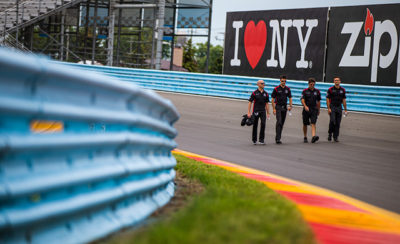Walking (not riding) around the track can give you an edge over the competition.
MazdaMotorsports.com has recently offered advice from Mazda’s IMSA WeatherTech SportsCar Championship MRT-24 Prototype drivers on learning new tracks and how to prepare for a new track before you arrive. There is another step to familiarizing oneself with a circuit that happens after arrival, and this step is important whether the track is new or not: The track walk.
“When doing a track walk, it’s very important to go out there – not on a bicycle, not on scooter or a golf cart … walk it. It’s called a track walk for a reason,” explains Joel Miller, pro driver and coach. “That’s so you can do the shuffle test. You go to the brake zone, you slide your feet on the line, off the line. Over time, you do this at all the tracks and you get a feeling for what’s going on. You’re going to find some tracks that have some grip, or the opposite. Also, when you’re walking the track, you can really feel the camber in the road. You can look at the curbs – are those curbs going to be potential use or not at all?”
While it’s a critical step for a new track, it’s important if you have been there before, also – especially if you haven’t been to that track in a while.
“Every year something changes on a road course,” says Tom Long, pro driver and coach. “The track settles, and maybe it’s a little more polished. You can pick up if an area is more polished or not, on line or off line, and that’s important to file away if you’re going to be driving in the rain. Case in point: A few years before Watkins Glen was repaved, you could definitely tell where the surface was polished and not. It happened to rain that weekend, and it was great advantage to walk the track and know you needed to avoid the inside here, or stay off this area there. As another example, at COTA, they ground the surface in the braking zones. You know as soon as go across the braking zone, you’re going to gain grip.”
You’re going to feel bumps as you walk that you may not on a golf cart, and those bumps could be important. They could also be different from when you were there last. The track surface may be different based on recent weather or what type of vehicles raced there last.
“Every track we go to, we walk it, no matter if we’ve been there five times or a hundred times,” says Tristan Nuñez, driver of the No. 55 RT24-P. “You want to know what the grip is like on the track. Some tracks will progressively get more bumps in certain places – Sebring is notorious for its bumps, so it’s always good to walk the track and see what kind of new bumps they have. You want to look for hazards, mainly. You’re not looking for braking points when you’re walking, because you get a different perspective when you’re actually in the car. So look for hazards such as bumps, ditches, anything that would catch you off guard when you’re in the car.”
The track walk is a critical step whether you’re visiting a track for the first time or not. The edge it gives you may be small, but that small edge may be all it takes to move you up in the finishing order.


 ACCESSIBILITY
ACCESSIBILITY